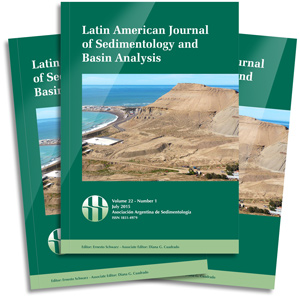Identification of microbially induced sedimentary structures over a tidal flat
Palabras clave:
Biostabilization; Microbial activity; Cyanobacteria; Zeolites; Bahía Blanca Estuary.Resumen
The influence of microbial activity in carbonatic environments leading to stromatolite build-ups is widely known. In siliciclastic environments, however, this influence has been far less studied. The present study was carried out in this type of environment and determined the importance of cyanobacterias in the preservation of sedimentary structures. Similar sedimentary structures were also recognized in the rock record by other studies. Therefore, if we know the environment of formation and conservation of such structures, then the paleoenvironment of the rock could be inferred.
In the tidal flats of the Bahía Blanca Estuary, microbial mats were identified. Their interaction with sediments, lead to a stabilized flat by shielding from erosion the existing sedimentary structures. Since it is the first time these structures are mentioned in a present-day environment in Argentina, a detailed description of the bio-sedimentological interaction is presented and our results compared with others from different climatic zones, namely, temperate humid and subtropical arid. Finally the occurrence of zeolites, an authigenic mineral, indicated that the sediment would be in the early stages of diagenesis.
Citas
Cornée, A., M. Dickman and G. Busson, 1992. Laminated cyanobacterial mats in sediments of solar salt works: some sedimentological implications. Sedimentology 39:599-612.
Cuadrado, D.G. and E.A. Gómez, 2006. Acumulación en planicies de marea causada por vegetación. Resúmenes IV Congreso Latinoamericano de Sedimentología y XI Reunión Argentina de Sedimentología:80, Bariloche, Argentina.
Cuadrado, D.G., E.A. Gómez, N. Pizani y E.R. Parodi, 2006. Bioestabilización de sedimentos en planicies de marea. Resúmenes VI Jornadas Nacionales de Ciencias del Mar y XIV Coloquio de Oceanografía:39, Puerto Madryn, Argentina.
Cuadrado, D.G. and E.A. Gómez, 2007. Preservación de estructuras sedimentarias en planicies de marea. Actas XII Colacmar. 3pp. Brasil.
Decho A.W., 1990. Microbial exopolymer secretions in ocean environments: their role(s) in food webs and marine processes. Oceanographic and Marine Biology: an Annual Review 28:73-153.
Dunham, R.J., 1962. Classification of carbonate rocks according to depositional texture. Memoir American Association of Petroleum Geologists 1:108-121.
Gelós, E. and J. Spagnuolo, 1982. Estudio composicional de los sedimentos de fondo de la ria de Bahía Blanca entre Puerto Cuatreros y Puerto Ingeniero White. RAGA 37(1):3-22.
Gerdes, G., Th. Klenke and N. Noffke, 2000. Microbila signatures in peritidal siliciclastic sediments: a catalogue. Sedimentology 47:279-308.
Giblin, A., 1988. Pyrite formation in marshes during early diagenesis. Geomicrobiology Journal 6:77-97.
Kantorowicz J.D., 1985. The petrology and diagenesis of Middle Jurassic clastic sediments, Ravenscar Group, Yorkshire. Sedimentology 32:833-853.
Krumbein, W.E., 1979. Photolithotropic and chemoorganotrophic activity of bacteria and algae as related to beachrock formation and degradation (Gulf of Aqaba, Sinai). Geomicrobiology Journal 1:139-203.
Krumbein, W.E., 1983. Stromatolites. The challenge of a term in space and time. Precambrian Research 20:493-531.
Naylor, L., 2005. The contributions of biogeomorphology to the emerging fiekd of geobiology. Palaeogeography, Palaeoclimatology, Palaeoecology 219:35-51.
Noffke, N., 1999. Erosional remnants and pockets evolving from biotic-physical interactions in a recent lower supratidal environment. Sedimentary Geology 123:175-181.
Noffke, N. and W. Krumbein, 1999. A quantitative approach to sedimentary surface structures contoured by the interplay of microbial colonization and physical dynamics. Sedimentology 46:417-426.
Noffke, N., 2000. Extensive microbial mats and their influences on the erosional and depositional dynamics of a silisiclastic cold water environment (Lower Arenigian, Montagne Noire, France). Sedimentary Geology 136:207-215.
Noffke, N., G. Gerdes, T. Klenke and W. E. Krumbein, 2001. Microbially Induced Sedimentary Structures: A New Category within the Classification of Primary Sedimentary Structures. Journal of Sedimentary Research 71 (5):649-656.
Noffke, N. and A.H. Knoll, 2001. Geobiology: Its application to sedimentary geology. Pardee Keynote Symposium, Annual Meeting Geological Society of America, Boston. Geological Society of America, Boulder, Colorado.
Noffke, N., G. Gerdes and T. Klenke, 2003. Benthic cyanobacteria and their influence on the sedimentary dynamics of peritidal depositional systems (siliciclastic, evaporitic salty, and evaporitic carbonatic). Earth-Science Reviews 62:163-176.
Noffke N., 2005. Geobiology-a holistic scientific discipline. Palaeogeography, Palaeoclimatology, Palaeoecology 219:1-3.
Noffke, N., N. Beukes, J. Gutzmer and R. Hazen, 2006a. Spatial and temporal distribution of microbially induced sedimentary structures: A case study from siliciclastic storm deposits of the 2.9 Ga Witwatersrand Supergroup. South Africa. Precambrian Research 146:35-44.
Noffke, N., K. Eriksson, R. Hazen and E. Simpson, 2006b. A new window into Early Archena life: Microbial mats in Earth´s oldest siliciclastic tidal deposits (3.2 Ga Moodies Group, South Africa). Geology 34:253-256.
Paterson D.M., 1994. Microbiological mediation of sediment structure and behaviour. In Cuamette P., Stal L.J. (eds), Microbial mats. NATO ASI Series:35-97.
Piccolo, M.C. and P.G. Diez, 2004. Meteorología del Puerto Coronel Rosales. In M.C. Piccolo y Hoffmeyer M. (ed), Ecosistema del Estuario de Bahía Blanca:87-90. Bahía Blanca, Argentina.
Pye, K., A.D. Dickinson, N. Schiavon, M.L. Coleman and M. Cox, 1990. Formation of siderite-Mg-calcite-iron sulfide concretions in intertidal marsh and sandflat sediments, north Norfolk, England. Sedimentology 37:3255-343.
Schieber, J., 1998. Possible indicators of microbial mat deposits in shales and sandstones: examples from the Mid-Proterozoic Belt Supergroup, Montana, USA. Sedimentary Geology 120:105-124.
Shin, E.A., 1983. Tidal flat environments. American Association of Petroleum Geologists Memoir 33:172-210.
Stal, L.J., 2000. Cyanobacterial mats and stromatolites. In Whitton, B.A. and Potts, M. (eds), The ecology of Cyanobacteria. Netherlands: 61-120.
Trummer, B. and U. Wirsching, 2000. Formation of zeolites in saline, alkaline-lake deposits: an experimental approach. In C.Colella and F.A. Mumpton (eds.), Natural Zeolites for the Third Millenium:211-225. Italy.
Walter, M.R., 1976. (ed). Stromatolites. Elsevier, Amsterdam, 790pp.
Welton, J., 1984. SEM Petrology Atlas. American Association of Petroleum Geologists. Tulsa Oklahoma, USA, 237 pp.
Descargas
Publicado
Cómo citar
Número
Sección
Licencia

Esta obra está bajo una licencia internacional Creative Commons Atribución-NoComercial 4.0.




